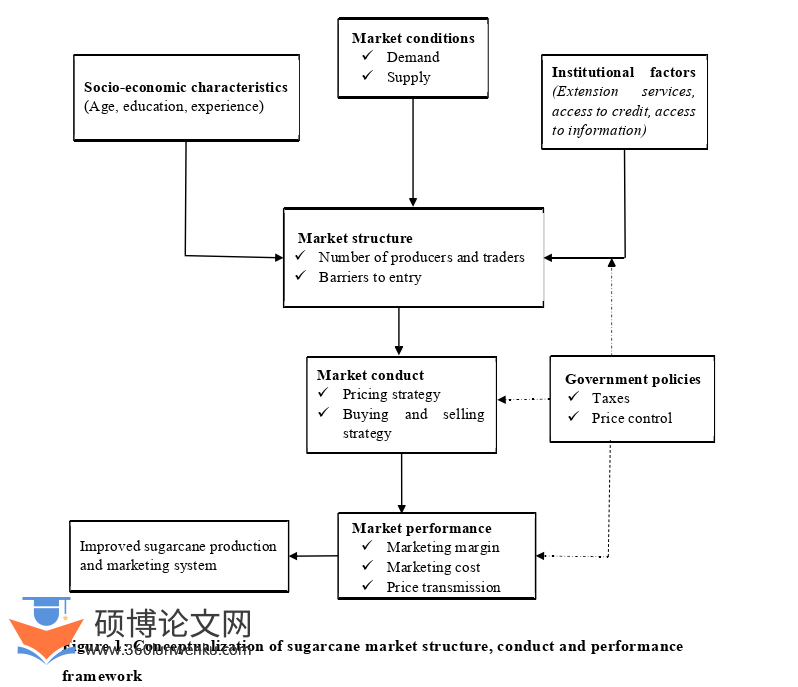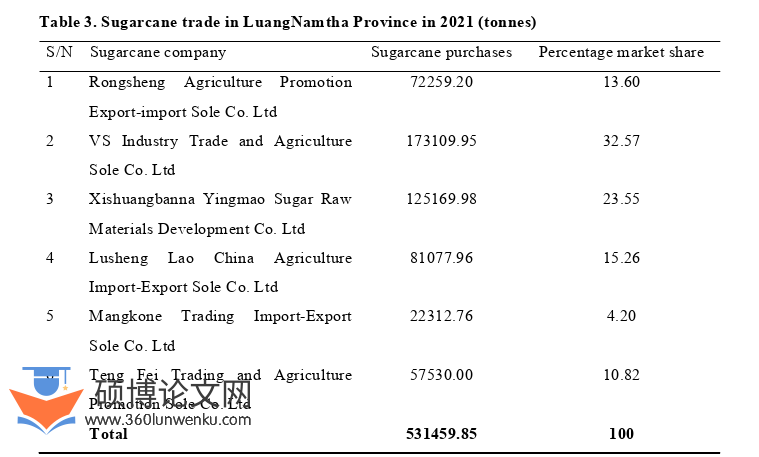本文是一篇经济论文,本研究ECM结果表明,甘蔗价格在短期和长期的调整过程都是不对称的,即存在非竞争性的市场结构。为了有效的营销,应努力改善甘蔗生产和营销方面,例如获得补贴、信贷、市场资料和营销基础设施以及降低甘蔗营销链上的交易成本。
CHAPTER ONE: INTRODUCTION
1.1 Background
The agriculture sector is one of the most important economic sectors in Lao PDR. The sector makes a significant contribution to food security and economic growth . In 2018, the sector contributed around 20.9 percent to Laos’ gross domestic product, third after service (45.9 percent), and industry (33.2 percent) . The sector also employs around 73.1 percent of the total labour force . However, for a long period, agricultural production in Laos remained at subsistence levels using traditional production techniques and was characterized by low productivity . The government has been implementing a number of policies to promote agricultural investment, such as the facilitation of export and import. As a result of the massive promotion policies and measures during the last decade, industrial crop plantations have undergone significant change, gradually industrializing and using modern production systems due to the massive influx of investments . Currently, almost 45 percent of farmers produce mainly for sale . Among agricultural products often produced as cash crops are mung-beans, soybeans, peanuts, tobacco, cotton, sugarcane, coffee, and tea.
Sugarcane production plays an important role in the Laos economy, both as a source of foreign exchange and as a livelihood for farmers scattered across various provinces of Lao PDR. It’s illustrated by the total area of sugarcane production (30,160 ha), which represents 56 percent of the total cultivated area . Of these, more than 78 percent are grown by smallholder farmers and the remaining 22 percent by large private estates . The contribution of the sugarcane and sugar confectionery export to the country’s agricultural exports reached $67.12 million in 2020 (11.3 percent), which places it in 5th position after rubber ($169.67M), edible vegetables and certain roots and tubers ($114.64M), coffee, tea, mate and spices ($99.79M), tobacco and manufactures tobacco substitutes ($77.00M).
............................
1.2. Problem Statement
LouangNamtha province produces most of the sugarcane in Laos, and China is a major consumer of sugarcane. Despite the increase in regional trade and the increase in sugarcane production in Laos in recent years, prices have not yet increased significantly, and sugar cane producers are still poor. The constraints to sugarcane trade and effectiveness of the marketing systems are not yet clearly known. Past studies have looked into the issue of market information systems in the region intending to strengthen them so as to correct supply and demand imbalances. However, the integration of sugarcane markets has received less attention; therefore, it is not known to which extent the variations in the prices of sugarcane at the exporters in Yunnan Province (China) are manifested quantitatively and temporally on the prices paid to producers in LouangNamtha province (Laos PDR) to facilitate steady product flows across markets. This knowledge would help develop policies that will stabilize the prices of sugarcane and increase its production, thus contributing to the improvement of the incomes and well-being of sugarcane producers in Laos.
On the other hand, the existence of relatively high transaction costs, the long marketing chain and the market power possessed by intermediary traders also affect the price transmission that occurs between farmers and exporters. Price changes are generally influenced by the existence of several costs that business actors must incur to adjust the price, or is called adjustment cost. These costs are divided into transaction costs, labelling costs, decision-making and contracting costs, and contract security costs [6]. The behaviour of intermediary traders and the absence of formal institutions that regulate exchanges such as buying and selling are also expected to increase transaction costs. In the absence of proper institutions that regulate the exchange of both sales and purchases, it is hoped that farmers can choose marketing channels that are not profitable. Generally, intermediaries will try to maintain their profit levels and not increase or decrease prices according to actual price signals. This will cause the margin formed in marketing from upstream to downstream (vertical) to be very large and inefficient, thus affecting farmers' income.
.............................
CHAPTER TWO: LITERATURE REVIEW
2.1 Introduction
This chapter reviews the theoretical and empirical literature on international trade and market efficiency. The chapter begins by presenting some definitional aspects of the terms and concepts of the study. A clear understanding of these terminologies is essential for explaining the sugarcane cross-border trade and market efficiency in Laos. The chapter further covers theoretical approaches relevant to the study. This is followed by a presentation of previous studies that have analyzed the efficiency of agricultural markets, and international trade. The chapter ends with a conceptual framework of the study.

经济论文怎么写
............................
2.2 Overview of Sugarcane Market Structure in Laos PDR
2.2.1 The evolution of the sugar industry in Laos
The sugar industry in Laos has evolved since the 1990s with the establishment of contract farming with a Chinese sugar factory located in the Pong district, which borders the Sing district. The local government encouraged farmers to grow sugar cane, while the factory provided technical assistance and financial support. Before sugar became an export product to China, sugarcane productions were mainly at subsistence levels and used traditional production techniques [17]. Only a small quantity of products was sold on the Lao-Chinese border market.
The sugar industry in Laos has developed over the past few decades as the country has experienced rapid economic growth and development. In the 1970s, sugar production was largely concentrated in small family businesses that relied on manual labor and traditional production methods (Kenney-Lazar 2019). As the country became more industrialized and globalized, larger plantations began to emerge, often with foreign investors. These modernized plantations introduced mechanized production methods and improved production standards to increase output and efficiency. According to Napasirth and Napasirth (2018), today, the sugar industry in Laos is booming. The country is now one of the world's leading sugar exporters thanks to its favorable climate and relatively low operating costs. Industry continues to modernize as more efficient machines and technologies are introduced and production standards improve. The Laos government also supports the industry by providing incentives and financial support to help local producers compete in the global market. As the industry continues to expand, it is expected to create even more jobs and economic opportunities in the country (Solomon et al. 2016).
According to (Zhang et al. 2022) the Laos Ministry of Agriculture, the average productivity of sugarcane plantations in the province is around 76.2 tonnes per ha. It is slightly higher than the value of productivity across the country. In 2019, the district exported 306,476 tonnes of sugarcane to China, with an average export price of 447,669 LAK (Lao Kip) per tonne. The total value of sugarcane exports was estimated to be approximately 137,199.8 million LAK (Lao Kip) in 2019, which is approximately 75% of the total value of district export.
.................................
CHAPTER THREE: METHODOLOGY ........................ 17
3.1 Introduction ................................... 17
3.2 Study Area ....................................... 17
CHAPTER FOUR: RESULTS AND DISCUSSION ............................... 23
4.1 Introduction ............................ 23
4.2 Marketing Efficiency ............................... 23
CHAPTER FIVE: CONCLUSION AND RECOMMENDATIONS ....... 43
5.1 Conclusion ............................................. 43
5.2 Recommendations ......................... 44
CHAPTER FOUR: RESULTS AND DISCUSSION
4.1 Introduction
This chapter discusses the sugarcane marketing system using a Structure, Conduct and Performance (SCP) approach. The market structure analyzed is market share, market concentration and barriers to market entry. While the analysis of market conduct includes marketing, sales and purchasing activities, and collaboration with marketing agencies. Analysis of market performance includes marketing margins, farmers’ shares and price transmission. The analysis can be seen in the results and discussion described in detail below.
This analysis is used to determine the level of commercial coverage of the major sugarcane-purchasing companies in Laos. The national market share is obtained from the ratio between a company’s turnover and the total turnover (Farris et al, 2007). Due to limited data, the calculation of companies' market share in this study was calculated using the production approach. In other words, the market share was by the ratio of sugarcane purchases over the total sugarcane production in LuangNamtha Province. Market share is an indicator of how well a company can work with its competitors (Farris et al, 2007). Changes in purchases will help companies assess the level of competition in the market. The loss of market share can be a sign of the emergence of problems and the need to adjust the company's strategy. Companies whose market share is below a certain level will lead to unsustainability of the company in the long term. The higher market share shows the strength of the company in the Laos sugarcane industry.

经济论文参考
.............................
CHAPTER FIVE: CONCLUSION AND RECOMMENDATIONS
5.1 Conclusion
Based on the results and discussion on the sugarcane market in Laos PDR, it can be concluded that:
Analysis of the structure of the sugarcane market in LuangNamtha Province tends towards the oligopoly. Almost 86.40% market share is dominated by private companies. The sugar market in LuangNamtha Province faces a concentrated market with a low degree of competition. This is indicated by a C4 value of 0.85 and an HHI of 2.202. In addition, there are barriers to entry into the marketing of sugarcane in the LuangNamtha Province. This is indicated by the mean value of the minimum efficiency scale (MES) from 2016 to 2020 of 27.61.
An analysis of the sugarcane market behaviour in LuangNamtha Province shows that there are marketing institutions which tend to be dominant in the implementation of marketing activities for sugarcane. The marketing institution is a large trader. The farmers' sugarcane buying activities that are carried out tend to cause collusion among the large traders, which results in the pricing of the sugarcane by these parties. The absence of a role for farmer groups in farmers 'sugarcane sales activities has led to a weakening of farmers' bargaining power.
reference(omitted)
